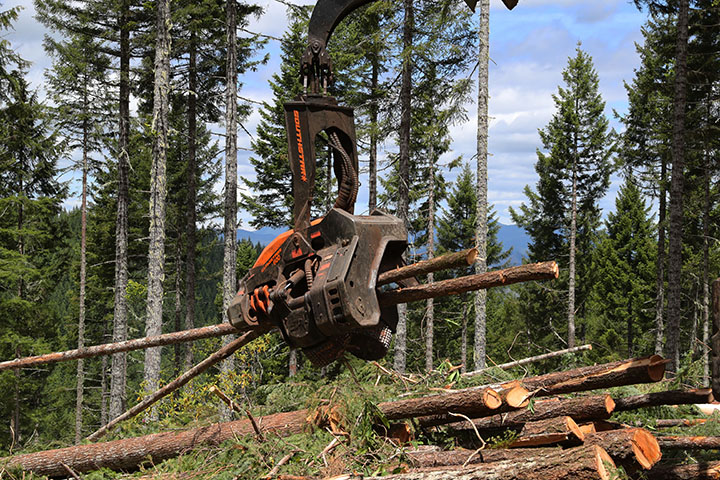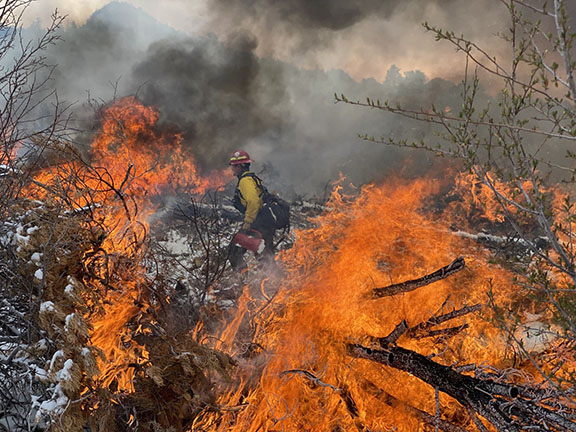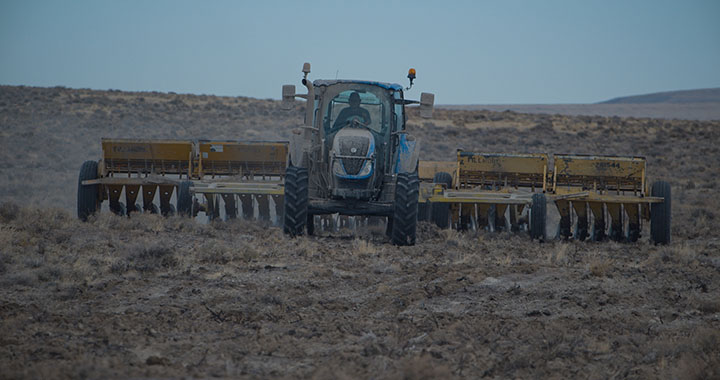The BLM conducts fuels treatments for a variety of ecosystems and land management needs:
Mechanical Treatments
Mechanical treatments include thinning, chipping, crushing, hand and machine piling, masticating, lopping and scattering small trees, shrubs or limbs, and mowing.
Mechanical treatment involves vehicles such as masticators, chippers, wheeled tractors, crawler-type tractors, or specially designed vehicles with attachments designed to cut, uproot, or chop existing vegetation.
Mechanical treatments can also be done with hand tools and hand-operated power tools to cut, clear, or prune vegetation. Treatments include cutting undesired plants above the ground level; pulling, grubbing, or digging out root systems of undesired plants to prevent sprouting and regrowth; cutting at the ground level or removing competing plants around desired species; or placing mulch around desired vegetation to limit undesired plant growth.
The selection of a particular mechanical method is based upon factors like the treatment objectives, existing vegetation, soils, topography and terrain, climatic conditions, and local expertise gathered through experience, science and monitoring data which is used to determine treatment effectiveness.
Of the approximate 600,000 to 900,000 BLM acres treated annually over the last 10 years, approximately 50% of those acres were accomplished by mechanical treatment methods.
Prescribed Fire Treatments
Prescribed fire is the intentional application or management of fire under specified conditions where fuels, weather, and topography allow safe vegetation reduction to improve ecosystem health, reduce wildfire hazard, and improve wildfire resilience. Typical prescribed fire treatment types include broadcast burning, jackpot burning, and machine and hand pile burning. Additionally, in areas where there is minimal threat to human life or property and land use plan documents allow, wildland fires are used for resource benefit to maintain ecosystems that are functioning within their normal fire regime.
Of the approximate 600,000 to 900,000 BLM acres treated annually over the last 10 years, approximately 25% of those acres were accomplished through prescribed fire treatment methods.
Biological and Chemical Treatments
Biological treatments involve the intentional use of domestic animals, insects, nematodes, mites, or pathogens (agents such as bacteria or fungus that can cause diseases in plants) that weaken or destroy vegetation. Biological control is used to reduce targeted weed populations to acceptable levels by stressing target plants and reducing competition with desired plant species.
Chemical treatments involve either manually or mechanically applying herbicides used to reduce invasive species like cheatgrass. These treatments are most commonly applied following removal of vegetation after mechanical or prescribed fire treatments. Then native or more desirable vegetation is seeded or planted to improve fire resilience.
Of the approximate 600,000 to 900,000 acres treated annually over the last 10 years, approximately 25% of those acres were accomplished through biological and chemical treatment methods.
What happens after treatment?
BLM's 1 million acre treatment goal
The BLM has outlined a plan to achieve at least 1 million acres of fuels treatments annually on BLM-managed public lands, and to sustain that level of treatment for the next five years with expected funding increases. BLM has developed a national five-year wildfire risk assessment and will focus treatments in priority areas to protect and restore landscapes and to reduce wildfire risk near communities.
In fiscal year 2023, BLM is planning to treat approximately 1.1 million acres and is working to increase capacity towards sustaining the bureau’s 1 million acre treatment goal. By increasing fuels accomplishments, the BLM will improve firefighter and public safety; reduce wildfire impacts and costs; maintain and restore fire-resilient landscapes; and create long-term natural resource benefits. This plan will also involve adding contracting, grants and agreements capacity, as increasing fuels projects cannot be achieved without investing in these capabilities.
Who does the work?
Fuel treatment projects are planned and carried out by fuels management and wildland fire personnel, with assistance and approval by field and district managers, and involvement from other BLM resource management specialists who ensure impacts to wildlife, soils and water, and other natural resources are mitigated where necessary.
BLM’s resource and wildland fire management specialists are responsible for implementing treatments, planning with partners and cooperators, assessing and inventorying, conducting the required National Environmental Protection Act (NEPA) analyses, and monitoring after treatment is completed to ensure treatment effectiveness. Fuels management actions are conducted using a combination of existing BLM personnel or are conducted through contracts and agreements with partners like private organizations, or other federal, state, county, or local government entities.
Planning, implementing and monitoring fuels projects occurs throughout the year, however, implementation can only occur when site conditions are favorable. Many wildland firefighters conduct prescribed burns and other fuels management projects in the spring, fall and winter months, when wildfire risk is lower and wildfire suppression activities are not occurring.











